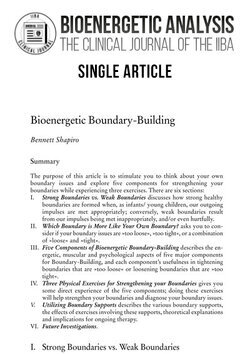24 Seiten, PDF-E-Book
Erschienen: März 2006
Bestell-Nr.: 36161
https://doi.org/10.30820/0743-4804-2006-16-155
Bennett Shapiro
Bioenergetic Boundary-Building (PDF)
Sofortdownload
Dies ist ein E-Book. Unsere E-Books sind mit einem personalisierten Wasserzeichen versehen,
jedoch frei von weiteren technischen Schutzmaßnahmen (»DRM«).
Erfahren Sie hier mehr zu den Datei-Formaten.
Abstract:
The purpose of this article is to stimulate you to think about your own boundary issues and explore five components for strengthening your boundaries while experiencing three exercises. There are six sections: I. Strong Boundaries vs. Weak Boundaries discusses how strong healthy boundaries are formed when, as infants/ young children, our outgoing impulses are met appropriately; conversely, weak boundaries result from our impulses being met inappropriately, and/or even hurtfully. II. Which Boundary is More Like Your Own Boundary? asks you to consider if your boundary issues are »too loose«, »too tight«, or a combination of »loose« and »tight«. III. Five Components of Bioenergetic Boundary-Building describes the energetic, muscular and psychological aspects of five major components for Boundary-Building, and each component’s usefulness in tightening boundaries that are »too loose« or loosening boundaries that are »too tight«. IV. Three Physical Exercises for Strengthening your Boundaries gives you some direct experience of the five components; doing these exercises will help strengthen your boundaries and diagnose your boundary issues. V. Utilizing Boundary Supports describes the various boundary supports, the effects of exercises involving these supports, theoretical explanations and implications for ongoing therapy. VI. Future Investigations.
Margit KoemedaS. 7–8Editorial Note (PDF)
Virginia Wink HiltonS. 9–28Reich, Lowen and the IIBA: facing the challange of a conflict-ridden world (PDF)
Ron RobbinsS. 29–48What’s the Use of Violence? (PDF)
Michael MaleyS. 49–62Shock, Trauma, and Polarization: Finding Unity in a World of Dualities (PDF)
Elaine TuccilloS. 63–85A Somatopsychic-Relational Model for Growing an Emotionally Healthy, Sexually Open Body from the Ground Up (PDF)
Diana GuestS. 87–101Bioenergetics and a Paradoxical View of Sexuality: how characterological development is related to current erotic life! (PDF)
Margit Koemeda-LutzS. 103–127Is there Healing Power in Rage? (PDF)
The relative contribution of cognition, affect and movement to psychotherapeutic processesAnton LethinS. 129–153Explorations into the Neurological Basis of our Sense of Self (PDF)
Bennett ShapiroS. 155–178Bioenergetic Boundary-Building (PDF)
Virginia Wink HiltonS. 9–28Reich, Lowen and the IIBA: facing the challange of a conflict-ridden world (PDF)
Ron RobbinsS. 29–48What’s the Use of Violence? (PDF)
Michael MaleyS. 49–62Shock, Trauma, and Polarization: Finding Unity in a World of Dualities (PDF)
Elaine TuccilloS. 63–85A Somatopsychic-Relational Model for Growing an Emotionally Healthy, Sexually Open Body from the Ground Up (PDF)
Diana GuestS. 87–101Bioenergetics and a Paradoxical View of Sexuality: how characterological development is related to current erotic life! (PDF)
Margit Koemeda-LutzS. 103–127Is there Healing Power in Rage? (PDF)
The relative contribution of cognition, affect and movement to psychotherapeutic processesAnton LethinS. 129–153Explorations into the Neurological Basis of our Sense of Self (PDF)
Bennett ShapiroS. 155–178Bioenergetic Boundary-Building (PDF)

